This post may contain affiliate links. Please read our disclosure policy.
Butternut Squash is one of the most common and popular varieties of winter squash. Perfect for roasting, steaming, stuffing, and pureeing, learn all about how to pick, peel, and prepare delicious and versatile butternut squash to enjoy in all your favorite recipes including soups, salads, side dishes, and desserts.
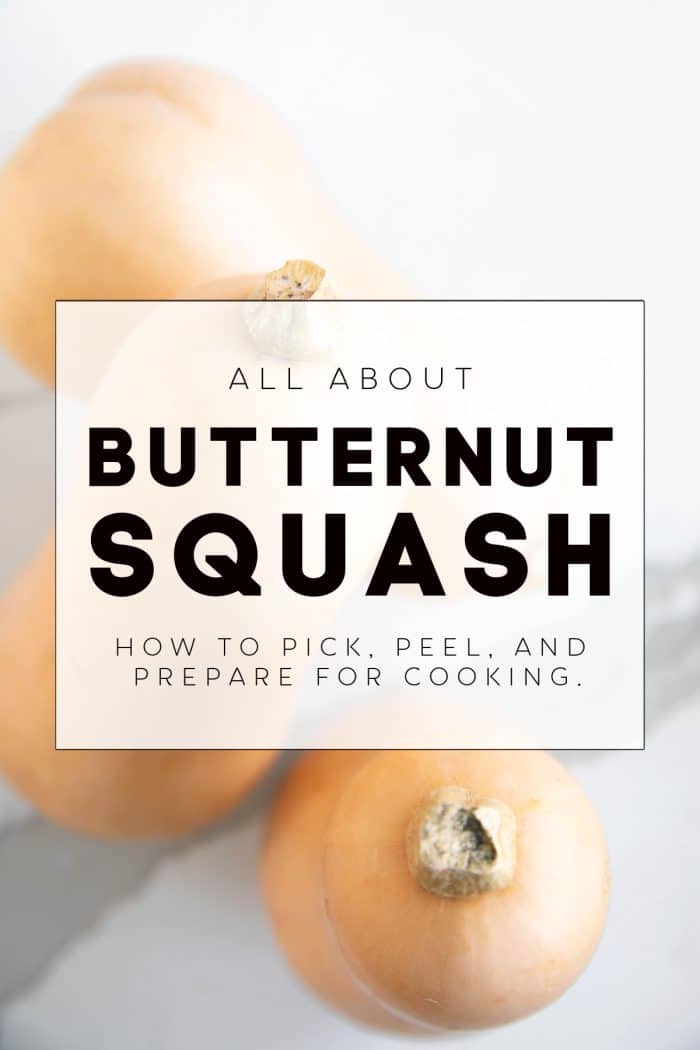
It is no secret that butternut squash is my very favorite squash to cook and eat. A member of the species C. moschata, butternut squash has beige-colored skin and bright orange-colored flesh. Similar in taste to pumpkin (whom it is also related), this winter squash is technically a fruit, but is used in cooking as a vegetable.
Prized for its naturally sweet, nutty taste, and versatility, butternut squash can be roasted, toasted, sauteed, pureed, mashed, stuffed, or used in baked goods like muffins and bread.
Health Benefits of Butternut Squash
In addition to being extremely versatile and delicious, it’s also highly nutritious.
Per 1 cup (205 grams) of cooked butternut squash:
- Calories: 82
- Carbs: 22 grams
- Protein: 2 grams
- Fiber: 7 grams
- Vitamin A: 457% of the Reference Daily Intake (RDI)
- Vitamin C: 52% of the RDI
- Vitamin E: 13% of the RDI
- Thiamine (B1): 10% of the RDI
- Niacin (B3): 10% of the RDI
- Pyridoxine (B6): 13% of the RDI
- Folate (B9): 10% of the RDI
- Magnesium: 15% of the RDI
- Potassium: 17% of the RDI
- Manganese: 18% of the RDI
Butternut squash is incredibly nutritious boasting nearly 500% of your RDI for vitamin A which helps regulate cell growth, eye health, bone health, and immune function.
It is also a great source of fiber with 7 grams per 1 cup of cooked squash. This is great for anyone.
Butternut squash is naturally gluten-free, vegan, vegetarian, plant-based, and dairy-free.
How to Pick Butternut Squash
Similar to picking out acorn squash, spaghetti squash, and kabocha squash, when it comes time to buy a butternut squash, pay close attention to these factors,
- Feel for a squash that is heavy for its size. The overall size doesn’t matter, as long as it is heavy for its size.
- If available, I try to buy squash with longer “necks”, especially when I’m cooking with butternut squash in bulk. In general, this makes for less overall peeling and chopping.
- Look for squash with a nice beige-ish color.
- Surface scratches and imperfections are normal, but deep scratches, cuts, or soft spots are not.
How to Peel and Cut Butternut Squash
There are a couple of different ways to peel and cut butternut squash. I have my preferred method, but use whichever method you’re most comfortable with.
Recommended tools and equipment:
Paring Knife (my preference) or Vegetable Peeler
I’ve found that some butternut squash are easier to peel than others, so if you’re just getting started cooking with this squash, try not to get too discouraged. This discrepancy often has to do with size, shape (one more reason to love squash with long necks), and maturity.
Tip – To make your butternut squash a little easier to peel, pierce your squash a few times with a fork and place the whole squash in the microwave. Microwave for 1-2 minutes. This will soften the skin just enough to make it easier to peel.
How to Peel, Seed, and Chop Butternut Squash:
- Slice off the stem and bottom ends of the squash. This creates a flat surface at both ends of your squash.
- Grab your vegetable peeler or paring knife. See what you’re more comfortable working with. I a much more comfortable with a paring knife and (if I’m being totally honest) find the several different types of vegetable peelers that I’ve tried using to peel butternut squash totally useless. That said, I do know some people use then, so try it out.
- Remember that every butternut squash is shaped a little differently, so how you tackle peeling one may not work for another. Sometimes I will peel my butternut squash whole before cutting in half horizontally or vertically. Sometimes, when it’s especially hard to peel, I like to cut into smaller segments.
- Remember, whether you’re using a Y-peeler or paring knife to always peel in downward strokes away from the body.
- Once all the skin is removed, scoop out the seeds using a metal spoon. Feel free to save the seeds for roasting or discard – totally up to you.
- Chop into slices, wedges, or cubes. Usually, I’ll chop my squash cubes into small 1-inch cubes.
How to Prepare and Season for Cooking
There are many different ways to prepare butternut squash for cooking. Most cooking methods require peeling but some do not.
Roasting is the most popular way to cook butternut squash. It’s easy, hands-off once it’s in the oven, and can be done with or without the skin on. Most commonly you’ll find butternut squash roasted cut in half vertically, with the seeds scooped out, but the skin still on, or, peeled, seeded, and chopped into small 1-inch cubes. Cooking time ranges from 25 minutes to 1 hour.
Slather with a little olive oil and season with salt and black pepper – that’s all you need for a simple, tasty side dish. Add additional winter veggies like Brussels sprouts, onions, or potatoes. For something a little sweeter (and very seasonal) try adding a drizzle of maple syrup or a sprinkle of brown sugar, ground cinnamon, and nutmeg.
One of my favorite ways to incorporate more of this sweet roasted squash into my diet is by swapping half of the called-for sweet potato amount with butternut squash. Perfect examples include these mashed sweet potatoes or this sweet potato and butternut squash shepherd’s pie.
Other popular cooking methods include steaming and sauteeing. Both methods work best (and fastest) when starting with butternut squash that is peeled, seeded, and cubed.
After cooking feel free to mash with a little salt and pepper and sprinkle of parmesan cheese for a fast and delicious lunch or weeknight dinner.
Helpful Squash Recipes and Tutorials
Spaghetti Squash; How to Cook Spaghetti Squash
What is Kabocha Squash (Japanese Squash)
If you try making one of these Butternut Squash Recipes, please leave me a comment and let me know! I always love to hear your thoughts.
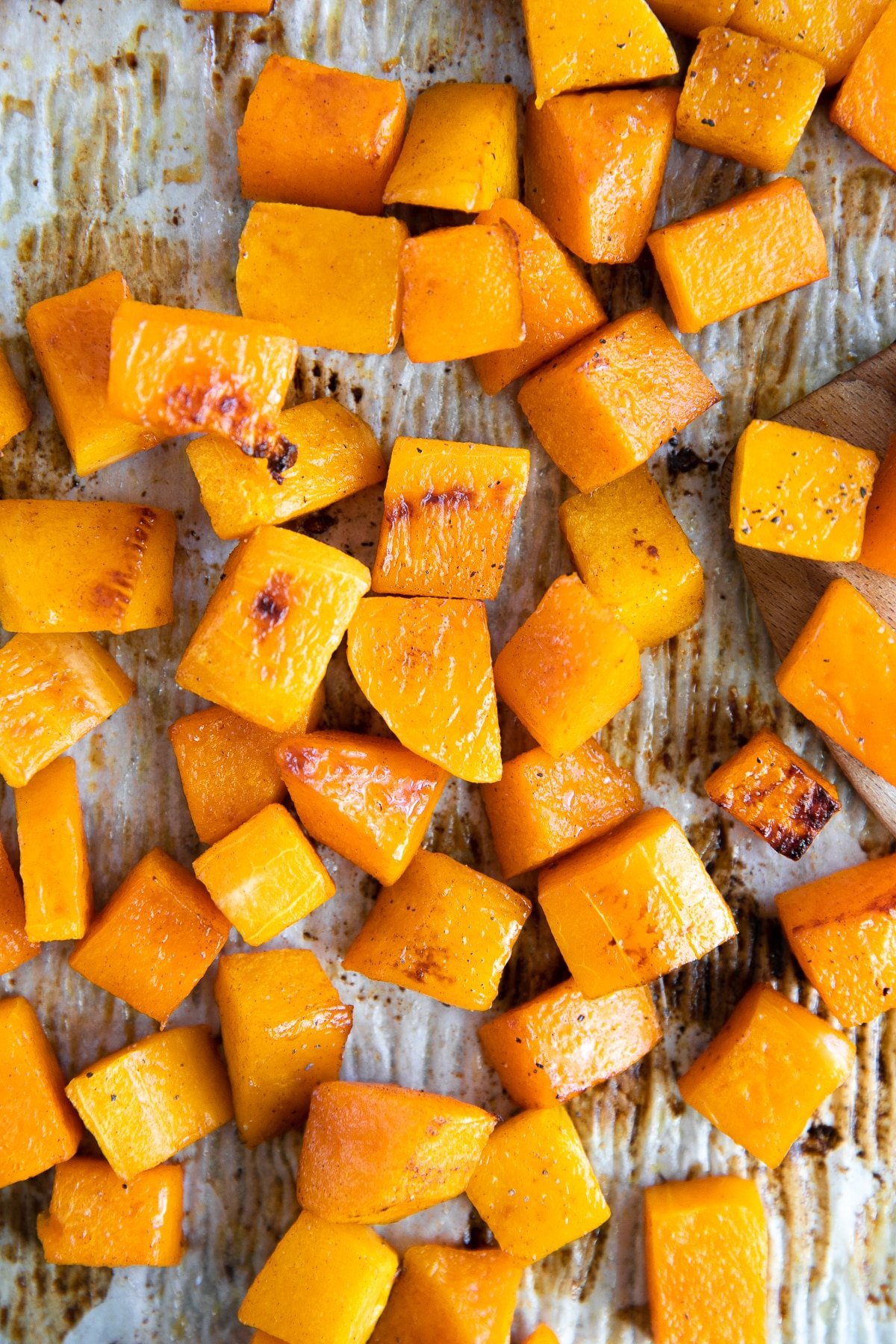
All About Butternut Squash: How to Pick, Peel, and Prepare Plus Recipes
Ingredients
- 1 whole butternut squash
- olive oil or butter, for roasting
- salt, black pepper, ground cinnamon, brown sugar, maple syrup, cayenne, seasonings of your choice, optional
Instructions
How to Pick Butternut Squash
- it’s important to look for butternut squash that is heavy for its size. The overall size doesn’t matter, as long as it is heavy for its size. I've found that squash with longer, thicker “necks” are easier to peel. Look for squash with a nice beige-ish color that is dull rather than shiny in appearance. Surface scratches and imperfections are normal, but deep scratches, cuts, or soft spots are not.
How to Peel, Seed, and Cut Butternut Squash
- Some butternut squash are easier to peel than others, so if you’re just getting started cooking with this squash, try not to get too discouraged. This difference often has to do with size, shape (one more reason to love squash with long necks), and maturity.
- Tip – To make your butternut squash a little easier to peel, pierce your squash a few times with a fork and place the whole squash in the microwave. Microwave for 1-2 minutes. This will soften the skin just enough to make it easier to peel.
- Slice off the stem and bottom ends of the squash. This creates a flat surface at both ends of your squash which will help with balancing your squash.
- Grab your vegetable peeler or paring knife. See what you’re more comfortable working with. I am much more comfortable with a paring knife and (if I’m being totally honest) find the several different types of vegetable peelers that I’ve tried using to peel butternut squash totally useless. That said, I do know some people use them, so try it out.
- Remember that every butternut squash is shaped a little differently, so how you tackle peeling one may not work for another. Sometimes I will peel my butternut squash whole before cutting in half horizontally or vertically. Sometimes, when it’s especially hard to peel, I like to cut into smaller segments.
- Remember, whether you’re using a Y-peeler or paring knife to always peel in downward strokes away from the body.
- Scoop out the seeds using a metal spoon. Feel free to save the seeds for roasting or discard – totally up to you. Chop into slices, wedges, or cubes. Usually, I’ll chop my squash cubes into small 1-inch cubes.
How to Roast Butternut Squash (Skin-On)
- Preheat oven to 375 degrees F. Line a large rimmed baking sheet with parchment paper or aluminum foil.
- Use a large, sturdy knife, to cut your butternut squash in half lengthwise. Scoop out the seeds using a metal spoon.
- Transfer the butternut squash, cut-side up onto your prepared baking sheet or baking pan, and brush with olive oil or melted butter. Coat the entire surface- skin and flash.
- Season as desired with salt, black pepper, brown sugar, ground cinnamon, etc.
- Transfer to the oven and bake for approximately 45 minutes, or until soft and easily pierced with a fork. Remember that smaller squash will cook faster than larger squash.
How to Roast Butternut Squash (Peeled)
- Preheat oven to 375 degrees F. Line a large rimmed baking sheet or sheet pan with parchment paper or aluminum foil.
- Peel and cut your butternut squash into small 1-inch cubes, slices, or wedges.
- Transfer cubes, slices, or wedges to a large bowl and toss with olive oil and desired seasoning.
- Transfer the butternut squash to your prepared baking sheet and spread in a single layer (use 2 baking sheets if necessary).
- Roast in your preheated oven for approximately 25-35 minutes, or until soft and slightly caramelized around the edges.
Notes
Nutrition
Nutrition information is automatically calculated, so should only be used as an approximation.
Favorite Butternut Squash Recipes
Whenever I think about butternut squash, I automatically think of soup recipes. It purees beautifully and tastes incredible with a little fresh garlic and ginger. But soup isn’t the only way to enjoy this awesome winter squash. Try adding it to salads, stews, grain bowls, tacos, or even your favorite dessert and breakfast recipes. You may be surprised by just how versatile this squash can be.

Butternut Squash Soup Recipe

Butternut Squash Tacos Recipe
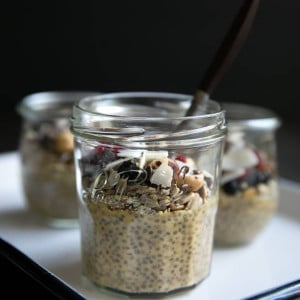
Butternut Squash Chia Pudding Recipe
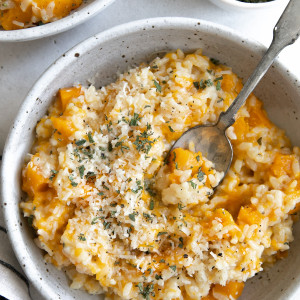
Easy Instant Pot Risotto with Butternut Squash Recipe
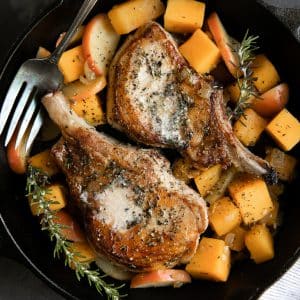
Pork Chops with Apples and Butternut Squash
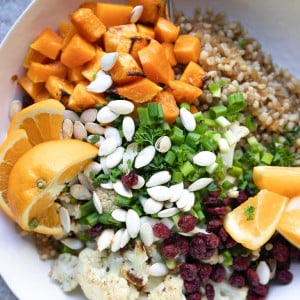
Wheat Berry Salad Recipe with Orange Shallot Vinaigrette



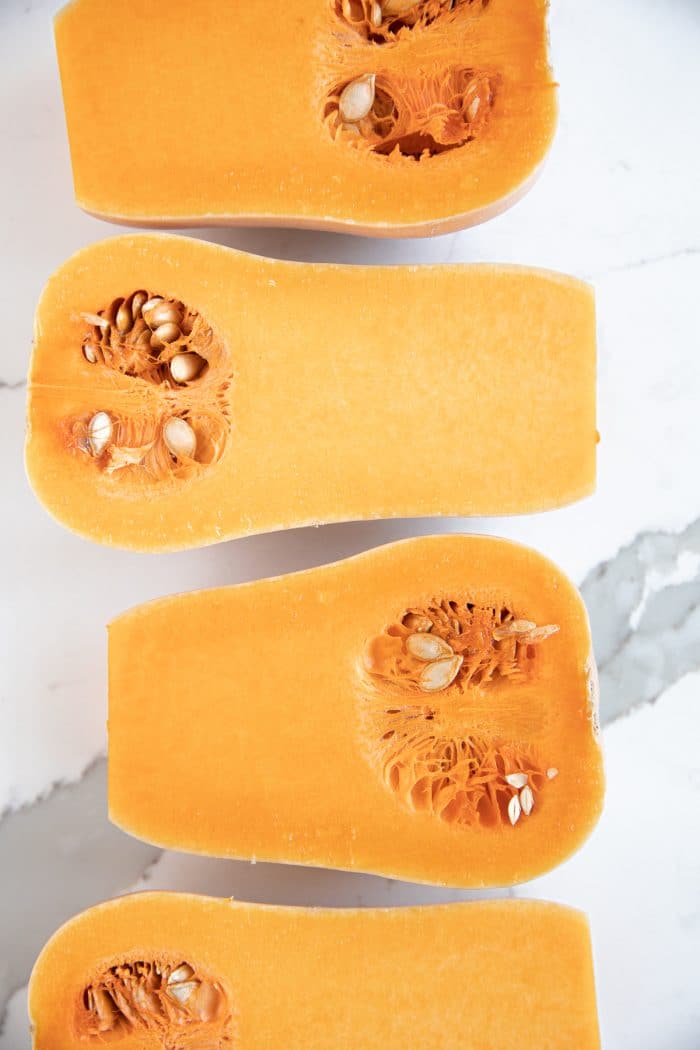


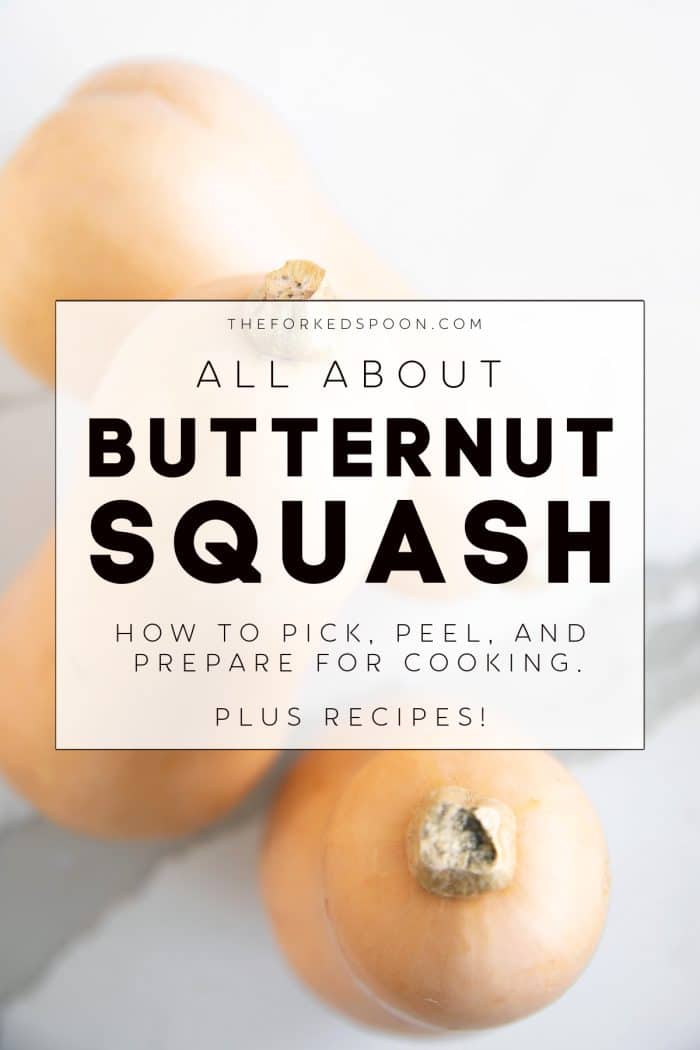


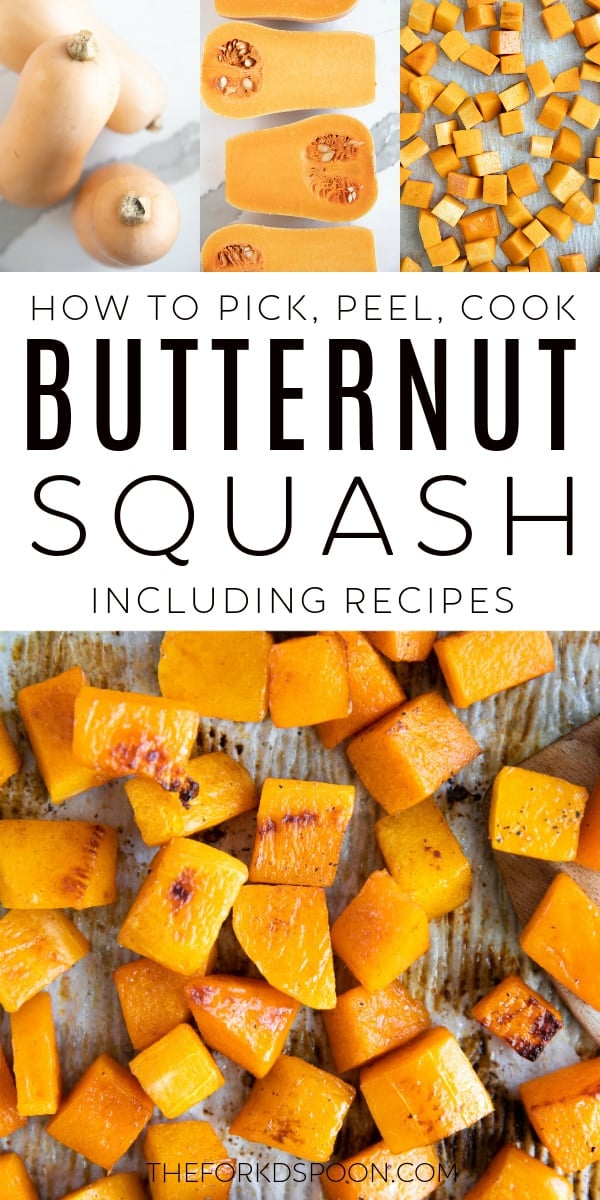


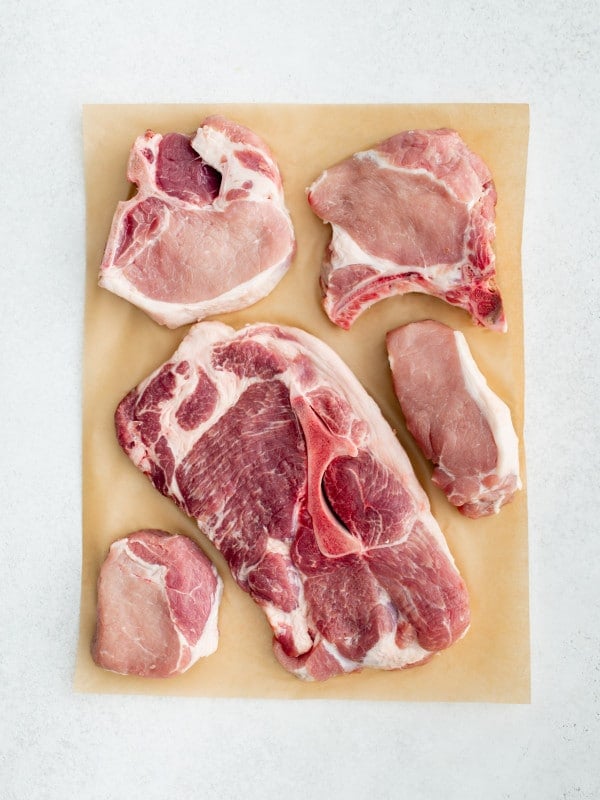










You prefer long necks. I prefer the ones that have the stem & blossom ends both about the same – thick waisted hour glass. As the seed “ball” is about the same regardless of the squash size, I figure I get more flesh that way. Also, they tend to sit more level when roasting.
While most of it is simply eaten mashed, my favourite is soup.
When freezing cubed butternut squash do you blanch them first? Some say just freeze the cubes for an hour on a tray and then transfer to a large freezer bag. We are harvesting over 40 from one plant. It’s our first time to grow them.
Sorry for the type-o… We have 30 Butternut Squash.
A quick blanch for about a minute for cubed butternut squash will help it retain its texture after thawing 🙂